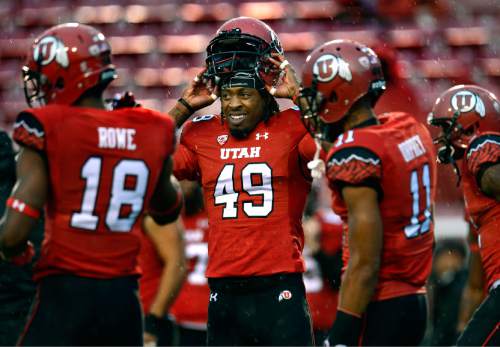This is an archived article that was published on sltrib.com in 2015, and information in the article may be outdated. It is provided only for personal research purposes and may not be reprinted.
Has there ever been a college football fan who hasn't watched a quarterback making a bad decision and yelled, "What was he looking at?"
Soon, college football fans might get to see exactly what quarterbacks are viewing.
There is growing interest in allowing helmet cameras in college football, possibly as soon as the 2016 season.
The interest is spurred by two elements, a desire by TV networks to give fans new and exciting angles to view games and by coaches who are interested in the cameras to give them more insight.
It turns out, fans aren't the only ones wondering what players are thinking out there.
"It's an interesting concept," said Utah coach Kyle Whittingham, whose teams have experimented with using helmet cameras in noncontact drills. "You're always looking for anything that will give you an advantage and it could help to watch the quarterback's progressions and focus on particular plays. But I'd have to see the footage to determine how much value it would have as a teaching tool."
Jeremy Jeansonne, the co-founder and CEO of Sports Video Innovations, believes Whittingham and other coaches will like what they see in the technology.
First developed in 2013 in collaboration with Schutt helmets, the SchuttVision cameras fit just above the facemask in the nose bumper of the helmet.
"The greatest challenge in developing the camera was making sure it would pass the NOCSAE [National Operating Committee on Standards for Athletic Equipment] certification test and making sure the design was as unobtrusive as possible to the helmet," Jeansonne said.
Thanks to camera technology, Jeansonne and his team made such a design work. It was embraced immediately in 2014 by the Arena Football League, which signed a deal to use the cameras.
According to Jeansonne, more than 30 NFL and college teams are experimenting with the helmets, including Notre Dame, Michigan, Clemson, Oregon and Texas Tech.
However, the experimentation has been limited to practice. While there is talk of possibly using the cameras in some bowl games this year, the cameras and their systems must be approved by the NCAA.
In 2014, the ACC was denied a request to experiment with helmet cams and coach-quarterback communications for the 2015 season, mainly because the request, which came in June, didn't give the NCAA rules committee enough time to discuss the matter.
The NCAA prevents the use of film for coaching purposes during a game, and cameras and microphones are prohibited at field level.
However, as more and more interest grows in the systems, the committee seems to be agreeable to their inclusion.
Air Force coach Troy Calhoun, who is the chairman of the NCAA Football Rules Committee, is in favor of changing the rules, acknowledging it could be a win-win situation for coaches as well as TV networks.
"Hopefully we can get it done this year or next," he said. "The technology is there. The cameras are so small it's not like the old days where they were so heavy you had to worry about it. Think of the views that we can get. It's something we can and should do."
Utah State coach Matt Wells is intrigued too, although he isn't sure if it will benefit quarterbacks or those who think they are quarterbacks.
"You're probably looking at creating some proficient arm chair quarterbacks," he laughed. "The ones who sit in their La-Z-Boys and think they have the best idea of what a quarterback should and shouldn't be doing."
Since its first introduction, the system has undergone renovations that include a larger field of view, quicker uploading and live streaming capabilities.
The unobtrusiveness of the camera has made it acceptable to the players, now it's just a matter of convincing the powers that be to allow the camera.
One hesitation by the NCAA could be a concern that smaller schools may not be able to afford the technology. However it's relatively inexpensive by college football standards, with a system of three SchuttVision helmets and the hot spot wireless box available for about $5,000.
Jeanesonne also said he is working on a leasing agreement for interested schools.
"The response from college coaches so far has been very good," he said. "They are always looking for new, innovative ways to help coach players and SchuttVision is a game changer when trying to capture point of view from a player safely."
The system still has to go through a series of testing with the NCAA before it is approved, but Jeanesonne is hopeful, while coaches are curious.
"I'm not sure it would be for pure entertainment for fans or good for coaching, I'd have to know a lot more about the pros and cons of it," Whittingham said. "But it's an interesting concept that could give you some unique shots."
Twitter: @lyawodraska



